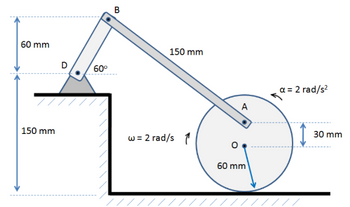
Elements Of Electromagnetics
7th Edition
ISBN: 9780190698614
Author: Sadiku, Matthew N. O.
Publisher: Oxford University Press
expand_more
expand_more
format_list_bulleted
Question
At the instant represented, the disk rolls without slipping with an angular velocity of 2 rad/s clockwise which changes at the rate of 2 rad/s^2 counterclockwise. Determine the corresponding angular acceleration of links AB and BD. At the instant considered, point A is directly above point O.

Transcribed Image Text:60 mm
150 mm
D
60⁰
B
150 mm
w = 2 rad/s
A
60 mm
a= 2 rad/s²
30 mm
Expert Solution
This question has been solved!
Explore an expertly crafted, step-by-step solution for a thorough understanding of key concepts.
Step by stepSolved in 5 steps with 18 images

Knowledge Booster
Learn more about
Need a deep-dive on the concept behind this application? Look no further. Learn more about this topic, mechanical-engineering and related others by exploring similar questions and additional content below.Similar questions
- At the instant shown in (Figure 1), rod AB has an angular velocity WAB = 2.2 rad/s and an angular acceleration AB = 10 rad/s². The collar at C is pin-connected to CD and slides over AB. Part A Determine the angular velocity of rod CD at this instant. Express your answer in radians per second to three significant figures. Enter positive value if the direction of velocity is counterclockwise and negative value if the direction of velocity is clockwise. Figure 60° WAB αAB 0.75 m Do 0.5 m 1 of 1 ΜΕ ΑΣΦ. Η vec WCD= Submit Request Answer Part B ? rad/s Determine the angular acceleration of rod CD at this instant. Express your answer in radians per second squared to three significant figures. Enter positive value if the direction of acceleration is counterclockwise and negative value if the direction of acceleration is clockwise. αCD= Η ΜΕ ΑΣΦ VAΣ IT vec Submit Request Answer B < Return to Assignment Provide Feedback ? rad/s²arrow_forwardAt the instant shown, the shaft and plate rotate with an angular velocity of 14 rad/s and angular acceleration of 7 rad/s?. Determine the speed and acceleration of point D, located in the corner of the board right now. Express the result in the form of a Cartesian vector. 0.6 m 0.2 m 0.4 m 0.3 m 0.3 m 0.4 marrow_forwardThe disk has an angular velocity of 8 rad/s and is increasing at the rate of 5 rad/s' about its Z- axis and the yoke AB has a constant angular velocity w = 3 rad/s about its shaft as shown. Simultaneously the entire assembly revolves about the fixed X-axis with constant velocity o, = 5 rad/s. Determine the velocity and acceleration of point F on the disc for an instant shown in the figure. Also find angular velocity and angular acceleration of the disc. 20 cm 15. 30 cm 30 cm 30 cm N 20 cmarrow_forward
- If the sprocket S is turning with an angular velocity ?S = 6 rad/s, and anangular acceleration of ?S = 2 rad/s^2. Find angular velocity and angular accelerationof link AB. Note that link AB shares an axis of rotation with sprocket S, but is free torotate separately from S (it’s not attached to the sprocket S). The pin at C is attachedto one of the chain links, and is moving vertically downward.arrow_forwardThe instant shown, bar AB has an angular velocity of 6.5 rad/s and an angular acceleration of 4 rad/s², both clockwise. 200 mm B 75 mm D 175 mm 100 mm A E Determine the angular acceleration of bar BD by using the vector approach. (You must provide an answer before moving to the next part.) The angular acceleration of bar BD is rad/s² clockwise.arrow_forwardEnd A of the 3.6-ft link has a velocity of 3.7 ft sec in the direction shown. At the same instant, end B has a velocity whose magnitude is 4.4 ft/sec as indicated. Find the angular velocity w of the link in two ways. The angular velocity of the link is positive if counterclockwise, negative if clockwise. A VA = 3.7 ft/sec 40° Answer: w= 3.6' B B VB = 4.4 ft/sec rad/secarrow_forward
arrow_back_ios
arrow_forward_ios
Recommended textbooks for you
 Elements Of ElectromagneticsMechanical EngineeringISBN:9780190698614Author:Sadiku, Matthew N. O.Publisher:Oxford University Press
Elements Of ElectromagneticsMechanical EngineeringISBN:9780190698614Author:Sadiku, Matthew N. O.Publisher:Oxford University Press Mechanics of Materials (10th Edition)Mechanical EngineeringISBN:9780134319650Author:Russell C. HibbelerPublisher:PEARSON
Mechanics of Materials (10th Edition)Mechanical EngineeringISBN:9780134319650Author:Russell C. HibbelerPublisher:PEARSON Thermodynamics: An Engineering ApproachMechanical EngineeringISBN:9781259822674Author:Yunus A. Cengel Dr., Michael A. BolesPublisher:McGraw-Hill Education
Thermodynamics: An Engineering ApproachMechanical EngineeringISBN:9781259822674Author:Yunus A. Cengel Dr., Michael A. BolesPublisher:McGraw-Hill Education Control Systems EngineeringMechanical EngineeringISBN:9781118170519Author:Norman S. NisePublisher:WILEY
Control Systems EngineeringMechanical EngineeringISBN:9781118170519Author:Norman S. NisePublisher:WILEY Mechanics of Materials (MindTap Course List)Mechanical EngineeringISBN:9781337093347Author:Barry J. Goodno, James M. GerePublisher:Cengage Learning
Mechanics of Materials (MindTap Course List)Mechanical EngineeringISBN:9781337093347Author:Barry J. Goodno, James M. GerePublisher:Cengage Learning Engineering Mechanics: StaticsMechanical EngineeringISBN:9781118807330Author:James L. Meriam, L. G. Kraige, J. N. BoltonPublisher:WILEY
Engineering Mechanics: StaticsMechanical EngineeringISBN:9781118807330Author:James L. Meriam, L. G. Kraige, J. N. BoltonPublisher:WILEY

Elements Of Electromagnetics
Mechanical Engineering
ISBN:9780190698614
Author:Sadiku, Matthew N. O.
Publisher:Oxford University Press

Mechanics of Materials (10th Edition)
Mechanical Engineering
ISBN:9780134319650
Author:Russell C. Hibbeler
Publisher:PEARSON

Thermodynamics: An Engineering Approach
Mechanical Engineering
ISBN:9781259822674
Author:Yunus A. Cengel Dr., Michael A. Boles
Publisher:McGraw-Hill Education

Control Systems Engineering
Mechanical Engineering
ISBN:9781118170519
Author:Norman S. Nise
Publisher:WILEY

Mechanics of Materials (MindTap Course List)
Mechanical Engineering
ISBN:9781337093347
Author:Barry J. Goodno, James M. Gere
Publisher:Cengage Learning

Engineering Mechanics: Statics
Mechanical Engineering
ISBN:9781118807330
Author:James L. Meriam, L. G. Kraige, J. N. Bolton
Publisher:WILEY